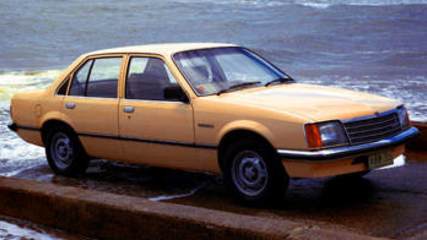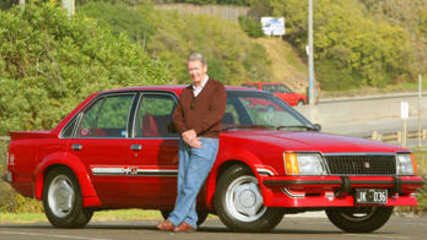Used Holden Commodore review: 1978-1980
By Graham Smith · 23 Jan 2009
As hard as it may be to believe, it’s official. The Commodore is a classic! Having blown out the candles on its 25th birthday cake the VB Commodore is eligible for special club registration, which makes the first new age Holden a classic in the eyes of the car club movement.Cars have to be at least 25 years old before they are eligible for a club permit, a cheaper form of registration which limits a car’s use to club related activities.Of the models that were released in the VB range in 1978 there is one that stands out head and shoulders above the others. It’s the SL/E and it’s the model that will most likely be the one that will be highly sought by the classic enthusiasts.The Commodore was born in Europe, but bred right here in Australia. It came as the result of the difficulties experienced with oil supplies when war broke out in the Middle East early in the 1970s.It was a rude awakening for all car makers who desperately sought ways of making their cars more fuel efficient after the price of fuel soared in the wake of supply problems.For its solution Holden turned to its German cousin, Opel, and joined the V-Car program, which resulted in the VB released in October 1978.It was the beginning of a new era for Holden, which began with a bang with Wheels magazine’s ‘Car of the Year’ award for the best new car of 1978. After starting on a high there would be lots of lows in the years to come, and it would take almost 20 years for the Commodore to win over the hearts and minds of Australian car buyers.MODEL WATCHTo create the Commodore Holden in effect took the Opel body and chassis and redesigned them to accept its own existing power trains.There was also some reinforcing done in certain areas of the body so it would stand up to the abuse it would receive on bush roads, and the suspension was retuned to suit local conditions.With MacPherson Struts under the front for the first time — there was a traditional Holden live axle under the rear — the VB was a sharp handling car that was more in line with what was coming from Europe than past Holden practice. It still rode comfortably and handled the rough and tough Aussie roads with aplomb.The power train was a problem for Holden that would persist, and get worse, through the 1980s. The gutsy old six-cylinder ‘red’ motor was introduced in 1963, in the EH, so it was getting a little long in the tooth by the time it saw service in the VB Commodore.With increasing demands for greener engines that used less fuel, the old Holden six needed changing, but with technology rooted in the 1960s it needed massive changes to meet the new demands.Instead of spending up big and developing all-new engines as it should have Holden tinkered with the old motor and came up with a compromise that really didn’t work all that well. Under the restrictions of rather rudimentary emission controls systems, old ‘red’ became a rough running unpleasant engine that still used too much fuel.Same goes for the V8, which was introduced in 1968 in the HT. While it wasn’t as old as the six the V8 was still a relatively old engine and didn’t take kindly to being run lean and retarded as the emission control systems made it.The engine problems would become more urgent in the 1980s, but in 1978 when the VB arrived Holden was full of optimism for the future.The VB was a smartly styled car with plenty of European panache, and the SL/E was the epitome of a European sports sedan, a tempting blend of luxury and performance.At the launch the SL/E came with an 87 kW 4.2-litre V8 as the standard engine, with the 114 kW 5.0-litre an option, but from 1979 you could also have an SL/E with the 71 kW 3.3-litre six.A T-bar three-speed auto was standard, as were four-wheel disc brakes, power steering, 15 x 6 alloy wheels with 60-series steel belted radials, air-conditioning, velour trim, wood grain, Blaupunckt AM/FM radio cassette sound, full instrumentation, and for a real touch of Europe it also had headlight washers and wipers.It was a sharp looking car then, and remains so today.ON THE LOTDon’t expect to find a VB SL/E lurking down the back of your local used car dealer, more than likely he’s sent it off to the recyclers. The best place to find a classic Commodore is in the classifieds where you’ll have plenty to choose from.Take your time, don’t rush in and buy the first car you see, unless of course it is a gem. When you find the car for you negotiate hard because VBs are hard to shift, they’re effectively at the end of their useful life and only of interest to classic car enthusiasts.Pay up to $3000 for that one little old lady owner low mileage 4.2-litre SL/E, up to $1000 more for one with a 5.0-litre V8. Don’t bother with the six, it’s the big-bore V8 that has the classic appeal.IN THE SHOPEarly Commodores haven’t aged gracefully. Rust is a major problem and it can often be seen in the bottoms of the guards and doors, below the rear window, and the floors can be a problem if the windows have been leaking.Paint is a major problem if it hasn’t been looked after, The metallic colours are the worst as can be seen by the fading that has frequently taken place on early Commodores.By now the body trim has either fallen off or is in the process of doing so, the doors have sagged, and the dash is cracked from the sun. In the days carmakers were moving from metal trim to plastic the plastic parts weren’t of a high quality.When new the alloy wheels looked a treat, but they were so detailed in their design that it was almost impossible to clean the brake dust out of the nooks and crannies and they soon looked terrible. The only way to keep them looking good was to regularly scrub away the dirt and grime, but few owners chose to do this and they suffered the consequences.Mechanically the VB suffered the same problems as other Holdens. The V8s were prone to oil leaks from the rear main crankshaft seal, the oil pan seal, the timing cover seal, and from the aluminium intake manifold which was prone to distortion.Camshaft wear was also a problem, particularly on the lobes at the rear end of the shaft where there was a problem with oil supply.Leakage from the cylinder head gaskets could also be a problem, usually caused by a problem with the clamping of the head to the block as a result of the cylinder head bolt pattern, which allowed the head to distort.The early emission control systems, which were mostly aimed at denying the engine much needed spark advance and cutting the fuel to the very minimum while still allowing the engine to run, robbed Holden engines of much of their power and performance and made them run roughly.The auto transmissions, the Trimatic was fitted to the six and the small V8, and the American Turbohydramatic 400 (later the 350) was fitted to the 5.0-litre V8, were mostly robust and reliable.Same with the rear end, which didn’t give much trouble, but look for vibrations in the drive shaft that might signal a drive joint on the way out.Most parts are available, either NOS from dealers, or from specialists like Rare Spares, so there’s no major problem in restoring a VB. Remember, though, that most classic car enthusiasts spend far too much money on restorations without the prospect of ever recovering their out of pocket expenses.OWNER’S VIEWSteve Stewart bought his 1978 VB SL three years ago as cheap transport to and from work to save the wear and tear on his motorcycles, but has since become a fan of the early Commodore.It was a very early VB off the line in 1978, was powered by the 4.2-litre V8 and Trimatic auto trans, and had the 310 Euro option pack that was made up of sports instruments, headlight washers and wipers and four-wheel disc brakes.The previous owner garaged it which explains its good original condition when Steve bought it, and the only thing he’s done is replace a worn distributor. There’s some minor rust showing in the passenger side front door, but a recent compression test showed that all was well inside the engine despite having clocked up 254,000 km.Steve calls his VB “Rocket 88” after the Ike Turner hit song from the ‘50s because it “goes like a rocket”.“It’s got a 2.78 axle so it’s not too sharp off the line, but it really gets going as it winds up,” says Steve. “And the good thing about it is that it’s a 1970s car so you don’t have to spend a lot of money on servicing or fixing it. You can do most things yourself.”LOOK FOR• rust is a major problem with early Commodores so inspect cars very careful, particularly look for corrosion around the windshield and rear window, walk away of you find any.• expect oil leaks from most engine seals, leaks from the rear main crankshaft seal will leave a stain on your driveway and cost a tidy sum to replace.• body hardware will most likely be shot, and need replacing. Look at operation of window winders, door locks etc. for an assessment of wear and tear.• doors sag on their hinges over time and doors flop as they’re opened. It’s not a maker task to resetting them, but sagging doors are a sign that time has taken its toll on the body.• faded paint, particularly the metallic colours, are a product of poor paint quality of the times. Most decent cars will need repainting to look their best.• look for suspension sag. Even though it was beefed up for Australian conditions, the Commodore body still drooped on the rough and tough Aussie roads.RIVALSClassic Aussie cars of the 1970s to consider include the 1976 XC Ford Fairmont – pay up to $4500 – a 1977 HZ Holden Monaro GTS – pay up to $6500 – or perhaps a 1974 Leyland P76 Targa Florio – up to $5000 – if you’re brave and want to be different.



